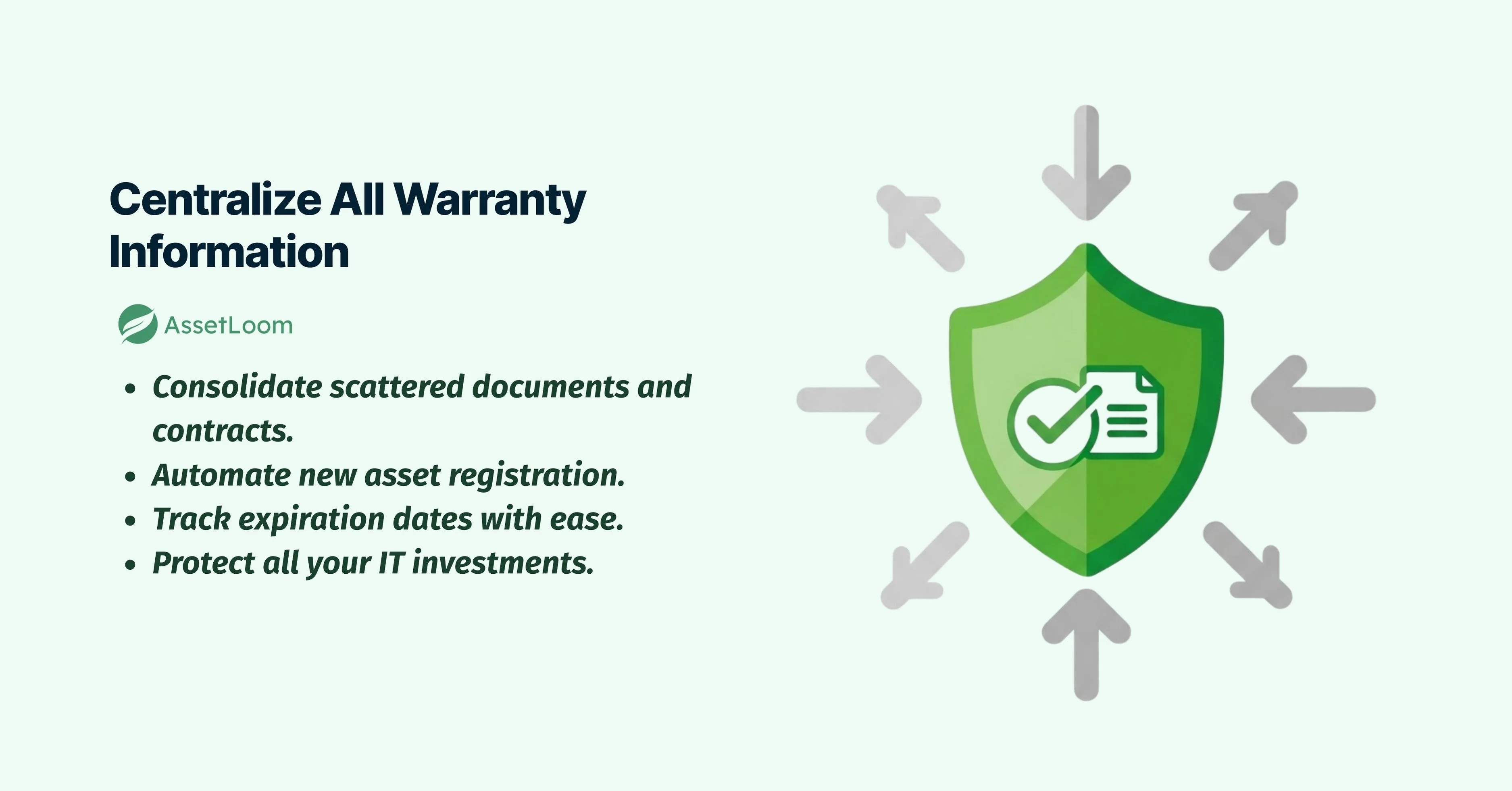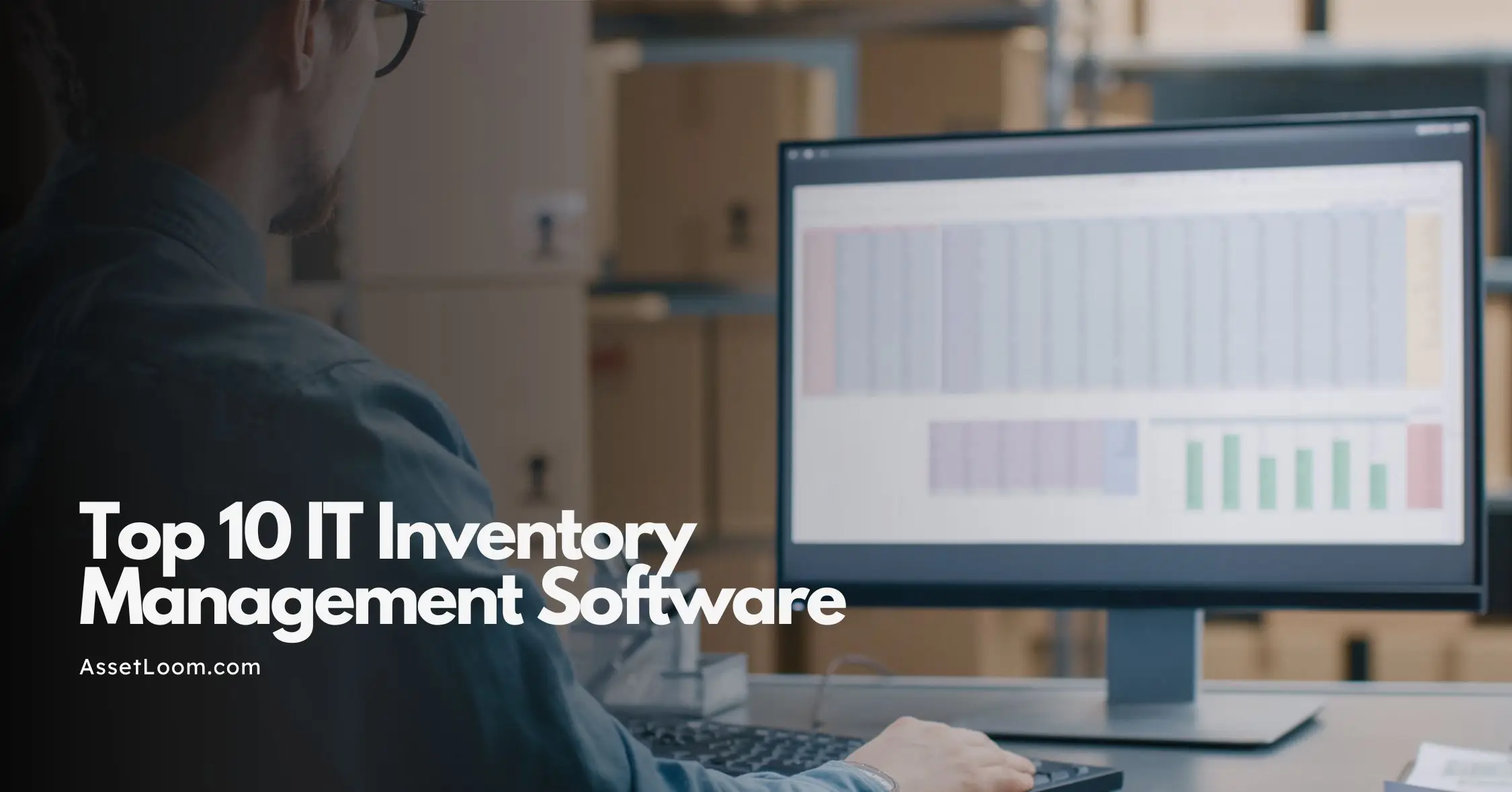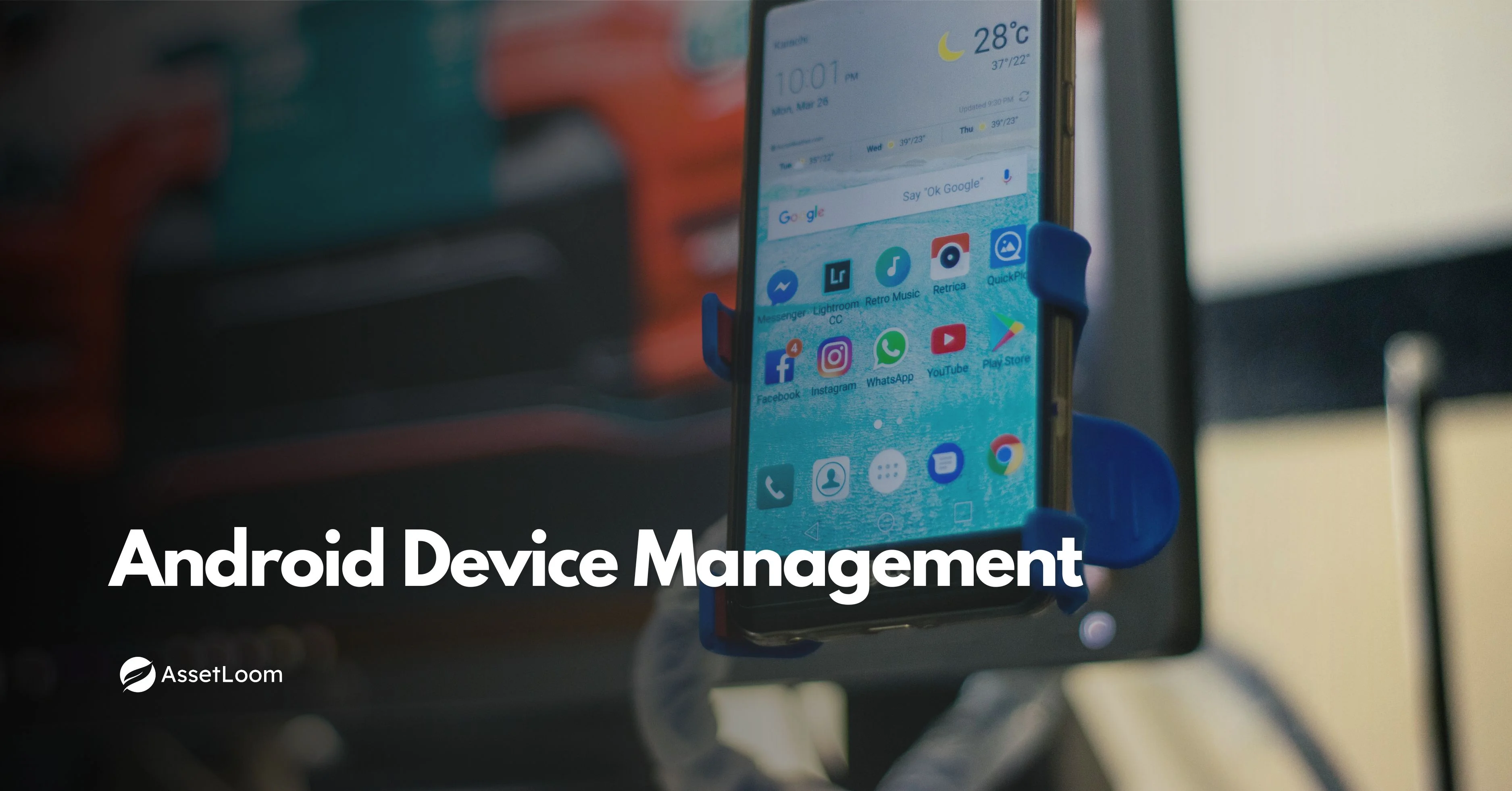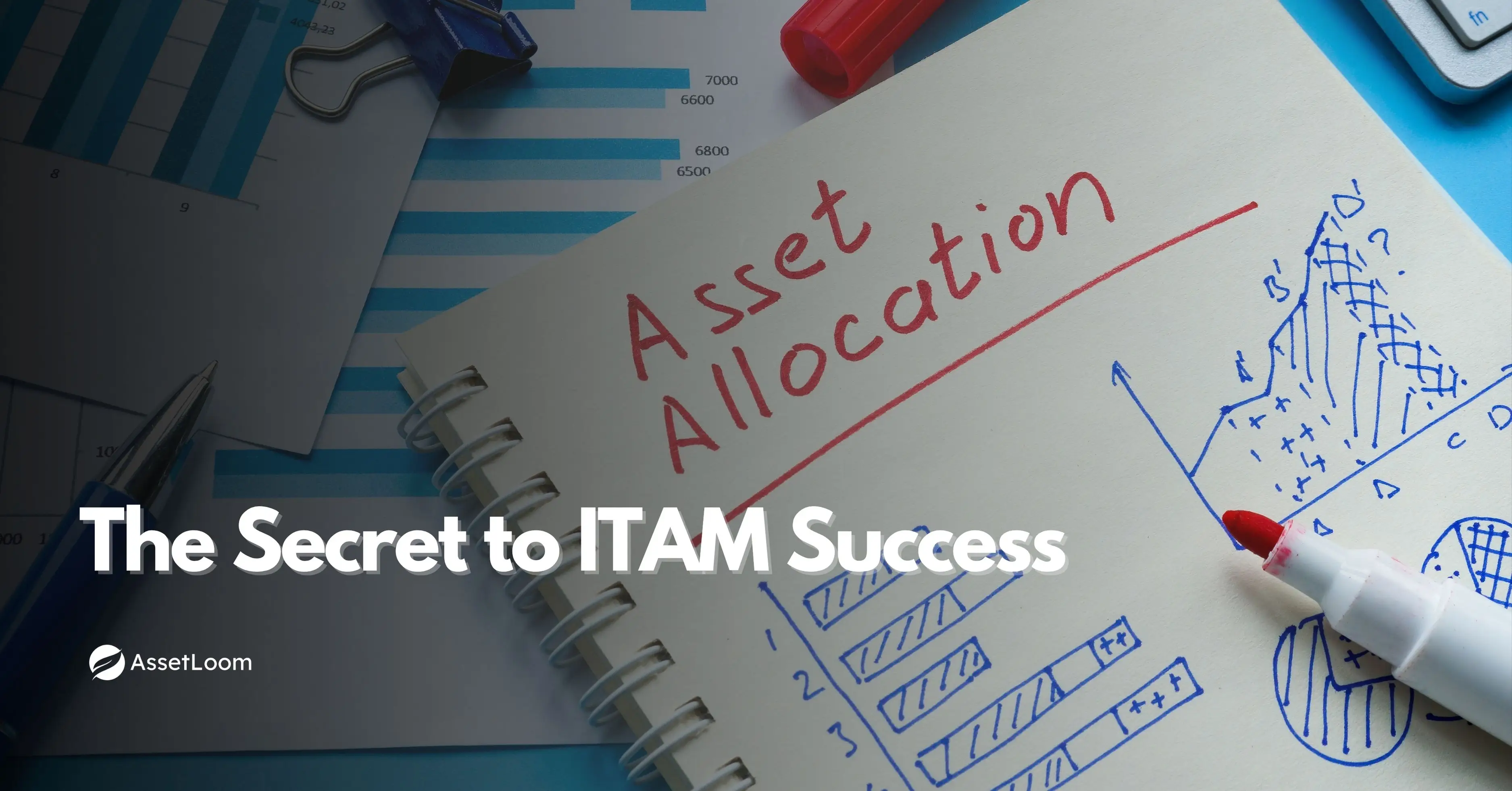Warranty Management Tricks to Extend Your IT Assets’ Lifespan
Discover effective warranty management tricks to extend your IT assets' lifespan and reduce costs with tools like AssetLoom.
Warranty management can play a crucial role in extending the life of your IT assets. When IT equipment breaks down unexpectedly, it leads to costly repairs, downtime, and sometimes, premature replacements. The good news is that, by properly managing warranties, you can avoid some of these issues and keep your assets running longer without unnecessary expenses.
By staying organized and using tools like IT asset lifecycle management software, you can ensure your assets are covered and maintain their performance over time. In this post, we’ll share practical tips to help you take full advantage of your warranties and get more years out of your IT hardware.
Centralize All Warranty Information
Managing warranties becomes much easier when all your information is in one place. If your warranty records are scattered across emails, paper files, or different spreadsheets, it's easy to miss important expiration dates or forget which parts are covered.

Here’s how you can centralize your warranty information for better management:
- Consolidate contracts: Keep all warranty details in one place. Whether it’s a spreadsheet, database, or specialized software, this will make it easier to track key dates such as expiration, coverage, and renewal options.
- Automate registration: Set up systems that automatically register new assets and their warranties as soon as they’re purchased. This reduces the risk of missing out on warranty claims and ensures that every asset is covered.
For example, imagine you manage dozens of laptops for your company. If each laptop’s warranty is stored in a different folder or spreadsheet, keeping track of renewal dates and coverage can quickly become overwhelming. But by centralizing the warranty info in one system, you can easily check which laptops are under warranty and which need attention. This helps you plan repairs and replacements more efficiently.
By consolidating contracts and automating registration, you reduce manual effort, minimize the chance of missing warranty details, and ensure your IT assets are always covered.
Automate Warranty Tracking
Tracking warranty expiration dates and coverage manually can be a time-consuming task. It’s easy to forget a renewal date or overlook an asset that needs attention. The solution? Automation.
![]()
- Set automated reminders for expiration dates: Use software to set reminders for when warranties are about to expire. This ensures you’re never caught off guard and gives you plenty of time to decide whether to renew or replace the asset.
- Track warranty claims and repairs automatically: With automated systems, you can track the status of warranty claims and monitor which assets have required repairs. This data helps you make informed decisions about whether an asset should be repaired again or replaced.
- Link warranties to maintenance schedules: Integrate warranty tracking with your asset’s maintenance schedule. If an asset needs servicing, you can check if the repairs are covered by the warranty before approving any costs.
Let’s say you manage a fleet of printers for an office. Instead of manually checking each printer’s warranty every time something goes wrong, an automated system can notify you when a printer is still under warranty and which parts are covered. This helps you save time and ensures you only pay for repairs that aren’t covered.
By automating warranty tracking, you eliminate the risk of missing out on claims, reduce manual effort, and make the warranty process far more efficient.
Register Assets Immediately After Purchase
One of the most common mistakes in warranty management is failing to register assets right after purchase. Many warranties require products to be registered within a certain time frame to be valid. By not registering an asset promptly, you risk losing warranty coverage entirely.
Here’s how to ensure you don’t miss out on this critical step:
- Register assets as soon as they arrive: When new IT assets are delivered, take the time to immediately register them for warranty coverage. This ensures that the warranty starts as soon as the product is in your possession, without any delays.
- Use bulk registration tools: If you're purchasing multiple assets, many manufacturers or IT asset management tools allow for bulk registration. This can save you time and ensure that all new assets are covered without having to register each one individually.
- Keep proof of purchase: Always retain receipts or invoices for every asset. Proof of purchase is often required when filing warranty claims, and having it readily available makes the process smoother.
For example, let’s say your company purchases 20 new laptops. If these laptops aren’t registered within the first 30 days, the warranties may be voided. By registering them as soon as they arrive, you ensure that each laptop is covered from day one, making it easier to claim repairs or replacements when needed.
Align Warranty Coverage with Maintenance Schedules
One of the most effective ways to maximize the value of your warranty is to align it with your asset's maintenance schedule. By synchronizing your warranty coverage with regular maintenance, you can prevent small issues from turning into costly repairs, and ensure that warranty claims are properly used for repairs or replacements when needed.
- Match maintenance checks with warranty terms: When scheduling routine maintenance for your IT assets, check whether the warranty covers repairs or replacements for certain issues. This ensures that you are not paying out of pocket for repairs that should be covered.
- Document service visits and repairs: Keep a record of all maintenance activities and any repairs that are done under warranty. This helps in future claims and ensures you stay on top of any recurring issues that could indicate the asset needs replacing.
- Optimize maintenance intervals: Adjust your maintenance intervals based on the warranty terms. For example, if an asset has a two-year warranty, you may want to schedule a maintenance check shortly before the warranty ends to catch any potential issues.
Imagine a server with a 3-year warranty. If you know the server is due for a maintenance check after 18 months, make sure to review the warranty coverage before the check-up. If there are any issues during maintenance that fall under warranty, you can have them addressed at no additional cost, saving your company money in repairs or replacement.
Negotiate Extended Warranties for Critical Assets
Not all IT assets are created equal. Some, like servers, high-end laptops, or critical networking equipment, are the backbone of your business operations. These assets are often in use around the clock, and if they fail, it could lead to significant disruptions. For these high-value assets, negotiating extended warranties can provide extra peace of mind and protection beyond the standard coverage.
Here’s how you can negotiate extended warranties effectively:
- Evaluate asset value and importance: Consider how essential each asset is to your business. For example, a server that stores company data is far more critical than a desktop monitor. For assets that are central to your operations, an extended warranty can prevent expensive repairs or downtime.
- Request extended coverage during procurement: When purchasing high-value assets, ask the vendor for extended warranty options. Many vendors offer extended warranties at a discounted rate if requested during the initial purchase, which can be a cost-effective way to increase coverage.
- Negotiate for all-inclusive warranties: Try to secure warranties that cover both parts and labor, as well as on-site repairs, for critical assets. This ensures that you won’t face hidden costs later on, and you’ll have quick access to repairs when needed.
Let’s say you purchase a new server for your company. The standard warranty might cover only one year of repairs and parts replacement. However, for a crucial asset like this, negotiating an extended warranty that covers five years with additional support can help ensure minimal downtime and avoid costly emergency repairs in the future.
By negotiating extended warranties for your critical assets, you protect your business from unexpected expenses and reduce the risk of operational disruptions.
Conduct Regular Warranty Audits
A warranty audit is a simple but powerful way to ensure you’re getting the most out of your warranty coverage. Over time, you might forget about certain warranties or fail to track assets that are no longer under warranty. Regular audits help you stay on top of which assets are covered and identify opportunities for renewal or replacement before coverage lapses.
- Review all assets periodically: Set a schedule to review the warranty status of all your IT assets at least once a year. This will help you identify any assets that are no longer under warranty and make plans to either renew or replace them as necessary.
- Check for expired warranties: During your audit, identify which warranties have expired or are about to expire. Renew warranties on valuable assets to avoid unexpected repair costs or downtime.
- Cross-reference with maintenance records: Compare your warranty records with maintenance logs. Ensure that any repairs made to assets under warranty are documented, and check if any assets need to be replaced due to recurring issues that aren’t covered by the warranty.
For example, let’s say you manage a fleet of company laptops. After performing a warranty audit, you might discover that several laptops have expired warranties, but their hard drives are still covered for another year. This information helps you prioritize which laptops to replace or repair first, ensuring you’re not paying for repairs that should be covered under warranty.
Conducting regular warranty audits ensures that you stay on top of your assets and avoid unnecessary expenses. You’ll also be able to spot opportunities to extend warranties or replace assets that are no longer reliable.
Use Warranty Insights for Smarter Procurement
Warranty data doesn’t just help you manage existing assets; it can also guide you in making smarter purchasing decisions for the future. By reviewing how different vendors’ warranties perform, you can choose products with better coverage, reliability, and long-term value. This can ultimately save you money and help avoid problems down the line.
Here’s how to use warranty insights to guide your procurement process:
- Track asset performance under warranty: Keep track of which assets are prone to failure or need frequent repairs during their warranty period. This data can help you identify which brands or types of equipment have more frequent issues, allowing you to choose more reliable options in the future.
- Evaluate vendor support: Review how responsive vendors are when it comes to warranty claims. Are they quick to replace faulty parts? Do they provide excellent customer service when issues arise? Knowing this can influence your decision when selecting a vendor for future purchases.
- Negotiate better warranty terms: Use your insights from past warranty claims to negotiate more favorable terms for future purchases. For instance, if you’ve had multiple issues with a specific product, you might ask for extended coverage or more comprehensive terms to ensure that future issues are covered.
Suppose your company has experienced repeated failures with a certain brand of network routers, even though they’re under warranty. By reviewing the warranty claims and support experience, you can decide to switch to a different vendor or negotiate a longer warranty for your next batch of routers. This helps reduce future downtime and unexpected repair costs.
How AssetLoom Helps with Warranty Management
AssetLoom is an IT asset management software that streamlines warranty management and helps you keep your assets running smoothly. Here’s how AssetLoom can assist:
- Centralized Warranty Tracking: AssetLoom allows you to store all warranty information in one easy-to-access location. This makes it simple to track expiration dates, coverage details, and renewal options for each asset.
- Automated Alerts: AssetLoom automatically sends alerts for upcoming warranty expirations, ensuring you never miss a renewal deadline. This helps you plan ahead and avoid costly repairs after warranties expire.
- Asset Registration: With AssetLoom, new assets can be registered automatically, linking the warranty details to each asset in real-time. This reduces the chances of forgetting to register assets and ensures every asset is covered.
- Maintenance Integration: AssetLoom integrates warranty details with your asset maintenance schedules. It ensures that repairs covered by the warranty are prioritized and helps prevent unnecessary out-of-pocket costs.
By using AssetLoom, you can simplify your warranty management process, extend the life of your IT assets, and save money on repairs and replacements.
Conclusion
Effective warranty management can significantly extend the life of your IT assets while saving your business money. By centralizing warranty information, automating tracking, registering assets promptly, aligning coverage with maintenance schedules, and negotiating extended warranties, you can avoid costly surprises and make the most of your coverage.
Regular warranty audits and using insights from past warranties can also guide smarter procurement decisions, ensuring you choose reliable products and vendors that best meet your needs. By following these simple tricks, you’ll not only keep your IT assets running longer, but also create a more efficient, cost-effective IT environment for your business.
Related Blogs:

Related Blogs
Subscribe for Expert Tips and Updates
Receive the latest news from AssetLoom. right in your inbox


